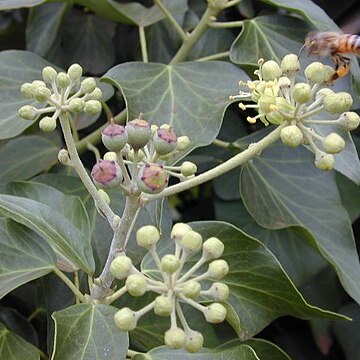Monoecious or dioecious trees, shrubs, climbers, scramblers or (perennial or annual) herbs, mostly evergreen (rarely deciduous), glabrous or with branched (often stellate or dendritic), multifid or simple hairs. Leaves spirally arranged (rarely opposite or whorled), simple or pinnately or palmately compound, base often clasping stem, margin entire, toothed or variously lobed; stipules usually inconspicuous, carnose or membranous, occasionally lacking. Inflorescence terminal or axillary, commonly a loose compound panicle, umbel or cyme (rarely racemose), occasionally simple umbels (rarely spicate). Flowers regular, usually small, aggregated into umbels or solitary, bisexual or unisexual, pedicellate or sessile; pedicels articulated near the receptacle or continuous with it; calyx lobed or reduced to a rim (rarely setose) or absent, persistent when present; petals 4 or 5 (rarely 3 or many), symmetrical (rarely asymmetrical), free (or rarely forming a cap or tube), usually caducous, imbricate or valvate in bud; stamens 4–many, often as many as petals and alternating with them, both inserted around an epigynous disc, usually caducous; ovary inferior or half-inferior (very rarely superior), surmounted by a secretory disc, commonly 2–5-locular (rarely unilocular), with one pendulous anatropous ovule per locule, styles as many as ovary locules, free or variously connate, persistent. Fruit a drupe or schizocarp, laterally compressed or spherical to globose, typically symmetrical (rarely asymmetrical); endosperm smooth or ruminate.
Trees, shrubs, lianes or (rarely) ± herbaceous, sometimes epiphytic, unarmed (at least in East Africa), with a simple or stellate indumentum, or glabrous. Leaves simple or compound; lamina coriaceous or chartaceous, often in some genera with differences in texture and outline between those of juvenile and mature parts of the plant. Stipules usually present. Inflorescences generally ample, ultimate branching very often umbellate or racemose. Flowers small, regular, often greenish-yellow, hermaphrodite, polygamous or dioecious. Calyx ± obconic, with tube adnate to ovary; free margin erect and very small. Petals 4–10, valvate, usually free, sometimes connate and calyptrate. Stamens equal in number to the petals and alternate with them, rarely more numerous, inserted (with them) on a disk. Anthers dorsifixed, dithecous, longitudinally dehiscent. Ovary inferior with 2–8 locules; styles distinct throughout or connate below into a stylopodium; ovules solitary, pendulous from the apex of each locule. Fruit a berry or a drupe, often with fleshy exocarp and an endocarp divided into distinct pyrenes or hardly distinct from the exocarp. Seeds with copious ruminate or smooth endosperm; embryo small and located near the hilum
Leaves alternate (rarely opposite), simple, pinnate or digitate; often coriaceous, glabrous or with a simple or stellate indumentum, the leaves of juvenile shoots often differing considerably from those of mature foliage; stipules frequently conspicuous
Flowers small, hermaphrodite (monoecious or dioecious outside the FZ area), actinomorphic; arranged in umbels, racemes or in compound combinations of these structures
Stamens free, alternating with the petals and usually similar in number, but occasionally more numerous; anthers opening by longitudinal slits
Ovary inferior, with 2–8 locules; styles often forming a distinct stylopodium and only free at the apex, sometimes free throughout
Ovary inferior, 1–or more-celled; styles free or connate; ovules solitary in each cell, pendulous from the inner angle
Petals (4)5(10), valvate or slightly imbricate, usually free but sometimes joined to form a calyptra
Leaves alternate or rarely opposite, simple or compound; stipules often adnate to the petiole
Trees, shrubs, lianes, suffrutices (very rarely herbaceous outside the FZ area)
Stamens free, alternate with the petals; anthers 2-celled, opening lengthwise
Flowers hermaphrodite or unisexual, spicate, racemose, umbellate or capitate
Seeds endospermous, endosperm smooth or ruminate; embryo very small
Calyx inconspicuous, with the tube adnate to the ovary
Ovules solitary in each loculus, anatropous, pendulous
Petals valvate or slightly imbricate, usually free
Seeds with copious endosperm and small embryo
Calyx adnate to the ovary, small
Fruit a berry or drupe
Fruit a berry or drupe
Disk epigynous
Mostly woody


